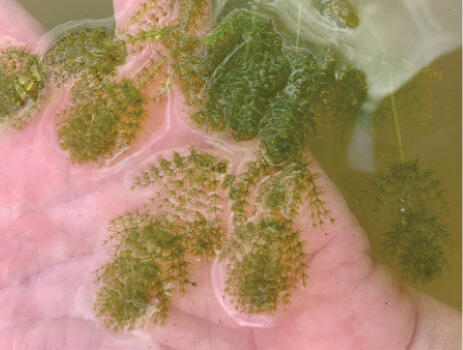P3735-02
Macroalgae | Chara and Nitella spp.


created by secondary branching.
At first glance, the macroalgae appear more like vascular plants than algae, but closer inspection reveals a lack of defined root, stem, or leaf structures. Two genera are common in Mississippi: Chara and Nitella. Both groups are highly desirable forage for grass carp, and this is the preferred method of control.
Chara
Commonly called “musk-grass,” Chara can form extensive beds of “moss” in clear, shallow water. Beds may be a few inches to several feet deep. Plants are anchored to the substrate by false roots, or rhizoids, which are typically colorless. Chara is easily distinguished from other macroalgae by its rough texture and strong musty or garlic-like odor. Individual internodes, or false stems, will have whorls of six to eight branchlets that do not have further branching. Chara prefers hard water. It is usually one of the first species to colonize newly constructed waterbodies (i.e., farm ponds).
Nitella
Nitella is closely related to Chara but prefers deeper water. Nitella is smooth to the touch and does not emit a musty or garlic odor. Nitella also has six to eight branchlets along the internodes, but these branchlets will have additional lateral and terminal branches that create a bushy appearance.
Management Value
Macroalgae are only a problem if their density reaches levels that interfere with aquatic activities like fishing and swimming. They are eaten by ducks, provide habitat and food for invertebrates, and provide some cover for fish.
Recommended Controls
Option 1: Triploid grass carp are the best, long-term solution. Stock five to ten grass carp per acre for moderate infestations. Use 15 or more per acre for severe problems. Triploid grass carp will not reproduce in ponds.
Stock 8- to 10-inch triploid grass carp in ponds that have established largemouth bass populations.
Option 2: Copper sulfate. If water alkalinity is at least 50 ppm, copper sulfate (pentahydrate) is the most economical solution. Treatment rate varies by species and alkalinity. Five pounds per acre-foot controls most infestations, which is about 30 pounds per surface acre for the average Mississippi pond. Dissolve at a rate of 1 pound per 5 gallons of water, and spray uniformly over the pond surface.
Option 3: Chelated copper. Apply a liquid chelated copper (0.9-pound formulation) at a rate of 0.5–1.0 ppm (1.5–3.0 gallons per acre-foot), depending on depth, plant height, and plant density. Determine pond volume prior to algaecide application.
Dilute 1 part chelated copper with 9 parts water and spray uniformly over the pond surface or use bottom injection (subsurface application using a wand or hose) to place the diluted liquid chelated copper where the algae grow. Copper can be toxic to fish when water alkalinity is low. Do not use copper in catfish or koi ponds when alkalinity is less than 50 ppm. Do not exceed annual herbicide rate limits as stated on the product label.
NOTE: Acre-foot = average depth of pond multiplied by pond acreage; average depth is calculated by taking the depth at 20 points across a water body and averaging the values.
Apply on sunny days when water temperature is above 60°F. Use of copper when alkalinity is less than 50 ppm may kill fish. For heavy blooms, treat only one-third of the pond at a time during the early morning hours. Wait 1 week between treatments of filamentous algae.
Read and follow all chemical label instructions, especially the section on the use of personal protection equipment.

The information given here is for educational purposes only. References to commercial products, trade names, or suppliers are made with the understanding that no endorsement is implied and that no discrimination against other products or suppliers is intended.
Publication 3735-2 (POD-11-23)
By Wes Neal, PhD, Extension/Research Professor, Wildlife, Fisheries, and Aquaculture; Dennis Riecke, Fisheries Coordinator, Mississippi Department of Wildlife, Fisheries, and Parks; and Gray Turnage, PhD, Assistant Research/Extension Professor, GeoSystems Research Institute.
